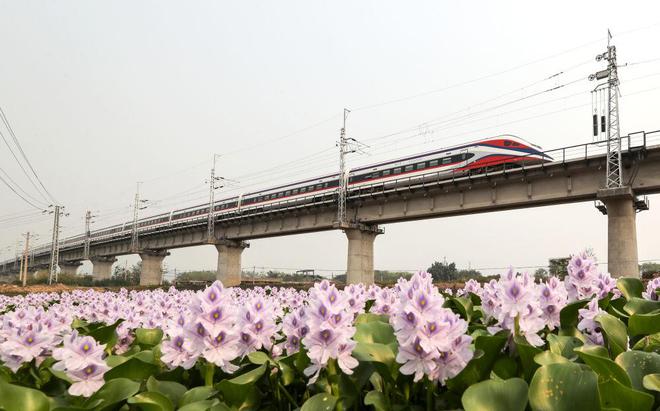China-Laos passenger rail gets running


International route to bring vast array of economic benefits to both nations
The high-profile China-Laos Railway opened to international passengers on Thursday, opening up new doors of opportunity to people on both sides, boosting economic potential and showcasing how the Belt and Road Initiative is a win-win endeavor.
The D887 train, departed from Kunming, Yunnan province, at 8:08 am and arrived at Vientiane, capital of Laos, at 6:38 pm.
An hour after D887's departure, the D888 train departed Vientiane to arrive in Kunming at dawn.
It is the first international cross-border passenger train service that China has put into operation since the COVID-19 pandemic.
The 1,035-kilometer railway, which commenced operations on Dec 3, 2021, is a landmark infrastructure project of the BRI.
As of Sunday, 13.93 million domestic passenger trips have been made along it and 18.38 million metric tons of cargo transported. A total of 3.59 million tons were cross-border shipments, according to China State Railway Group, the parent company overseeing construction and operation of the line.
The international passenger service has not been offered until now due to the COVID-19 pandemic.
"The service has not only further facilitated the flow of people and trade between China and Laos, but also presses the 'accelerator pedal' for the recovery of tourism and other industries, and injects new impetus to promote development between the two countries," said Wang Wenbin, spokesman for the Ministry of Foreign Affairs, at a news conference on Thursday.
"The China-Laos Railway is a model project of China and ASEAN countries working on the BRI and promoting regional economic integration," he said.
This year marks the 10th anniversary of the BRI, and China will continue to cooperate with Association of Southeast Asian Nations members to promote the initiative, benefiting 2 billion people in the region, he added.
Suanesavanh Vignaket, Lao minister of information, culture and tourism, welcomed Chinese tourists on Thursday at the city of Boten at the Laotian border with China.
"Before the epidemic, 1 million Chinese travelers visited Laos in 2019, about 21 percent of all travelers visiting Laos. Now we have the China-Laos Railway, which can provide more choices for Chinese travelers to Laos," she said.
On Thursday morning, Liu Jin and his 60-year-old mother boarded the train. He was so excited to be one of the first to experience the cross-border service.
He took photos of their tickets and passports and posted them on social media platforms.
Liu, 32, has traveled to Laos eight times in the past. He had traveled by bus, air, water and motorcycle, but for the ninth time he took the train.
"Traveling by train is much more comfortable, convenient and fast," he said, adding that he was confident to take his 60-year-old mother with him by train.
"I traveled by cross-border bus several times. It took about 30 to 40 hours to travel from Kunming to Vientiane. Staying in a limited space for more than 30 hours was a suffocating experience," he recalled.
Born and raised in Northeast China's Liaoning province, Liu is fascinated by the climate in Laos.
"Natural views are great there. I love the crystal sky and tranquil life, as well as heartwarming people," he said.
Lamphone Thipmala, a native of Vientiane, also took the train on Thursday.
"It is a pleasant and comfortable journey," she noted, adding that she will take the train again.
She studied in Guangzhou, Guangdong province before the pandemic and usually traveled between home and school by plane.
The 27-year-old is studying railway transportation and hopes to become a teacher at a railway vocational school in Vientiane.
"China's trains are so fast and advanced, and I hope I can learn more to teach students in my country, that we can have better railways and trains in the future," she said.
"The opening of the China-Laos Railway, especially the cross-border passenger service, makes travel between Kunming and Vientiane very convenient," said Su Yisheng, an expert in Southeastern Asian relations from Yunnan Social Studies Academy.
"Compared with over 40 hours of cross-border bus, it is much more comfortable for people traveling by train, benefiting those with travel needs between the two countries, such as students, tourists and business people."
He quoted a World Bank estimate that the gross domestic product in Laos will be increased by 21 percent as a result of the construction and operation of the China-Laos Railway.
It will also create more jobs for Lao people, he added.
"This year marks the 10th anniversary of the BRI project. China-Laos Railway, as the landmark transport project of the BRI, has turned Laos from a landlocked country into a land-linked hub. It is a win-win project for China and Laos and has benefited people from both sides," he said.
- Shenzhou XVI crew members given honors
- Beijing warns of heavy catkin season on way
- People rush to book May Day holiday trips while tickets last
- Xinjiang Wusu Brewery wins trademark case
- Ancient Beijing granary opens to public for 1st time
- CPC launches new round of disciplinary inspection, targeting economic, financial sector




































